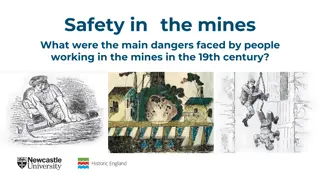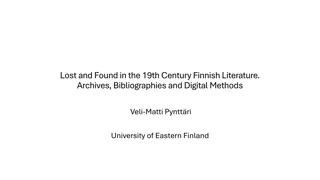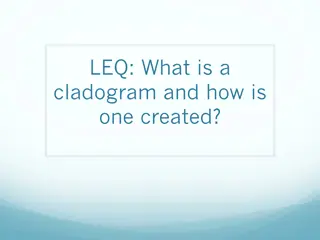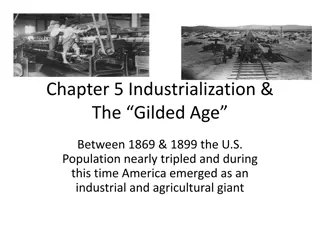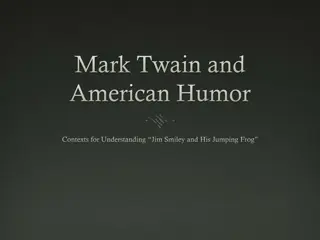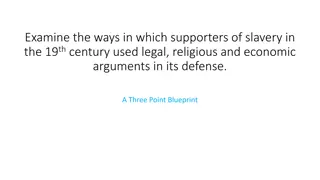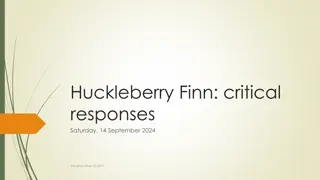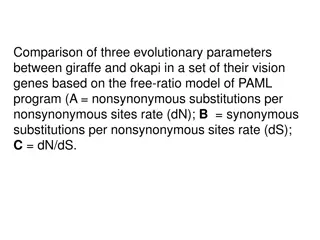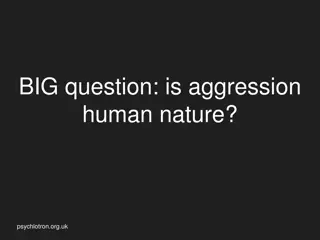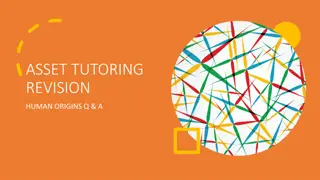Evolutionary Contributions of Prominent Scientists in the 19th Century
Charles Darwin, Gregor Mendel, Friedrich Miescher, Aristotle, and Carl Linnaeus were key figures in the 19th century who made significant contributions to the fields of evolution, genetics, DNA discovery, and taxonomy. Darwin proposed the theory of evolution and natural selection, Mendel established the laws of inheritance, Miescher identified DNA, Aristotle introduced theories on heredity, and Linnaeus laid the foundations of modern taxonomy.
Download Presentation

Please find below an Image/Link to download the presentation.
The content on the website is provided AS IS for your information and personal use only. It may not be sold, licensed, or shared on other websites without obtaining consent from the author.If you encounter any issues during the download, it is possible that the publisher has removed the file from their server.
You are allowed to download the files provided on this website for personal or commercial use, subject to the condition that they are used lawfully. All files are the property of their respective owners.
The content on the website is provided AS IS for your information and personal use only. It may not be sold, licensed, or shared on other websites without obtaining consent from the author.
E N D
Presentation Transcript
May Alrashed, PhD 2015-2016
2015-2016 May Alrashed, PhD
Charles Darwin (1809-1882) Established that all species of life have descended over time from common ancestry Proposed the scientific theory that this branching pattern of evolution resulted from a process that he called natural selection. He published his theory with compelling evidence for evolution in his 1859 book On the Origin of Species , overcoming scientific rejection of earlier concepts of transmutation of species. 2015-2016 May Alrashed, PhD
Gregor Johann Mendel (1822-1884) Scientist and Augustinian friar who gained posthumous fame as the founder of the new science of genetics. Mendel demonstrated that the inheritance of certain traits in pea plants follows particular patterns, now referred to as the laws of Mendelian inheritance. Gregor Mendel, who is known as the "father of modern genetics." 2015-2016 May Alrashed, PhD
Used Pisum Sativum (Graden Pea) in his study. There are 7 characteristics of pea in his study Published the results of his investigations of the inheritance of "factors" in pea plants. Mendelian laws of Inheritance 1. Law of Segregation 2. Law of Independent Assortment 2015-2016 May Alrashed, PhD
Friedrich Miescher (1844-1895) He was the first researcher to isolate and identify nucleic acid. Discovered a new type of weak acid, abundant in the nuclei of the white blood cell; Miescher's weak acid turned out to be the chemical substance we now call deoxyribonucleic acid or DNA. 2015-2016 May Alrashed, PhD
Aristotle The ancient Greek philosopher Aristotle contributed in tow theories: Pangenesis theory (according to which tiny particles are formed in different parts of the body. These particles migrate to the gametes and from there to the offspring where they guide the formation of the respective parts) Preformatonism there is a preformed bodies (Homunculus) that organisms develop from miniature versions of themselves A tiny person inside a sperm, as drawn by Nicolaas Hartsoeker in 1695 2015-2016 May Alrashed, PhD
Carl Linnaeus (1707 1778) Father of modern taxonomy. Laid the foundations for the modern scheme of binomial nomenclature. 2015-2016 May Alrashed, PhD
Three scientists who rediscovered Mendel's laws in 1900. They were all working independently on different plant hybrids, and came to the same conclusions about inheritance as Mendel. 2015-2016 May Alrashed, PhD
Walter Sutton (1835-1913) Pointed out the interrelationships between cytology and Mendelism, closing the gap between cell morphology and heredity. Fertilization. Affiliated the behavior of chromosomes to the genes. 2015-2016 May Alrashed, PhD
Avery, MacLeod, McCarty Reported that they had purified the transforming principle in Griffith's experiment and that it was DNA. DNA- genetic material 2015-2016 May Alrashed, PhD
Rosalind Franklin (1920 1958) an English chemist and X-ray crystallographer who made contributions to the understanding of the fine molecular structures of DNA Obtained sharp X-ray diffraction photographs of DNA. 2015-2016 May Alrashed, PhD
Martha Chase Alfred Hershey Used phages in which the protein was labeled with 35S and the DNA with 32P for the final proof that DNA is the molecule of heredity. Hershey shared the 1969 Nobel Prize in Physiology or Medicine with Max Delbr ck and Salvador Luria for their discoveries concerning the genetic structure of viruses 2015-2016 May Alrashed, PhD
Francis Crick, James Watson Solved the three- dimensional structure of the DNA molecule in 1953. DNA is double stranded. 2015-2016 May Alrashed, PhD
Summary 2015-2016 May Alrashed, PhD
2015-2016 May Alrashed, PhD
2015-2016 May Alrashed, PhD
SCOPE AND BRANCHES 1. Behavioral Genetics- examines the role of genetics in animal (including human) behavior. 2. Classical Genetics- consists of the technique and methodologies of genetics that predate the advent of molecular biology. 3. Conservation Genetics- interdisciplinary science that aims to apply genetic methods to the conservation and restoration of biodiversity. 4. Ecological Genetics- study of genetics in natural populations. 5. Genomics- discipline in genetics concerning the study of the genomes of organisms. 2015-2016 May Alrashed, PhD
SCOPE AND BRANCHES CYTOGENETICS Science that deals with the physical basic of heredity (cell) MOLECULAR GENETICS Chemical basis of heredity Newest and most advanced field of Genetics Genomic (Study of genes of an organism) Proteomics (study of proteins coming from DNA replication.) 2015-2016 May Alrashed, PhD
CLASSICAL GENETICS Study of analysis of offspring to mating (parents to offspring) POPULATION GENETICS Deals with the transmission of trait with a large group of individual through a passage of time. BEHAVIORAL GENETICS Study of behavior of an organism. 2015-2016 May Alrashed, PhD



